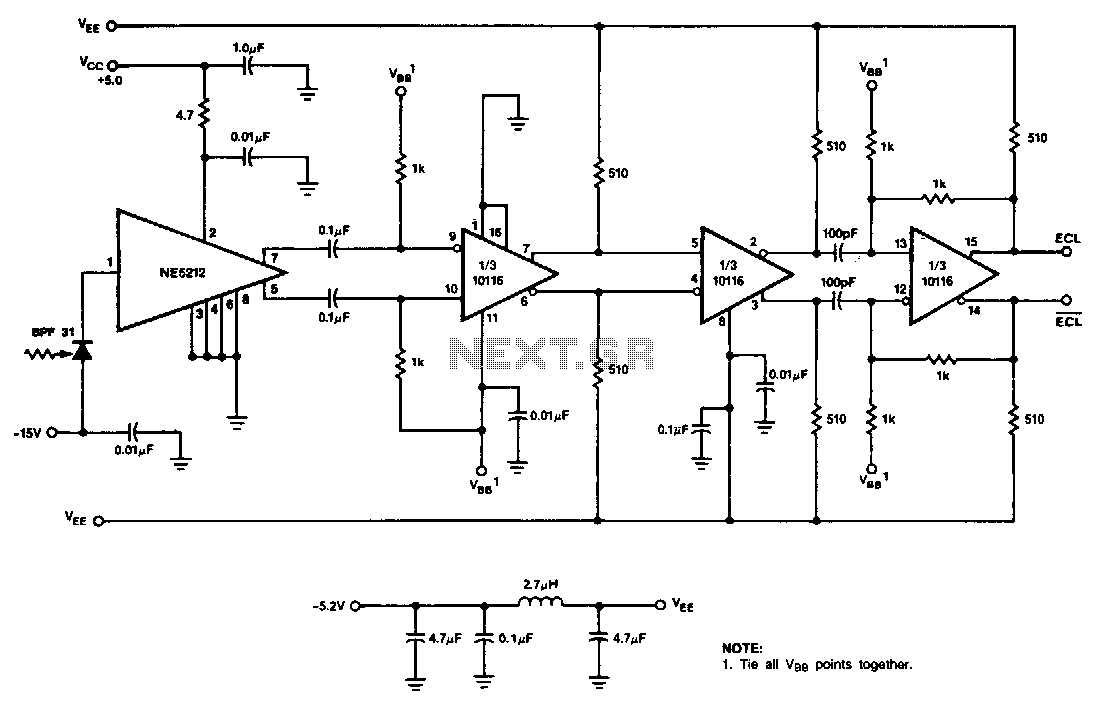
Digital-fiber-optic-receiver

This receiver utilizes the NE5212, the Signetics 10116 ECL line receiver, and the Phillips/Amperex BPF31 pin diode. The circuit is a capacitor-coupled receiver that employs positive feedback in the final stage to introduce hysteresis. The level of hysteresis can be adjusted for specific applications by modifying the feedback resistor values, allowing for an optimal trade-off between noise immunity and sensitivity. At room temperature, the circuit functions at a speed of 50-M baud with a bit error rate (BER) of 10E-10. Over the automotive temperature range, it operates at 40-M baud with a BER of 10E-9. Experimental diodes have enabled operation at speeds up to 220-M baud with a BER of 10E-10.
The described receiver circuit is designed to enhance signal integrity and performance in high-speed data communication applications. The NE5212 serves as a high-speed differential line receiver, which is integral in converting differential signals to single-ended outputs while minimizing noise susceptibility. The use of the Signetics 10116 ECL line receiver further complements this by providing low-voltage differential signaling, which is crucial for maintaining signal quality over longer distances.
The incorporation of the Phillips/Amperex BPF31 pin diode plays a vital role in the receiver's operation by enabling fast switching capabilities, essential for high baud rates. The capacitor coupling in the design allows for AC signal processing while blocking DC components, which can be beneficial in certain applications where DC offset may affect performance.
Positive feedback in the final stage is a critical design choice that introduces hysteresis, which stabilizes the output against noise and fluctuations in the input signal. This hysteresis can be fine-tuned through the selection of feedback resistors, allowing the designer to achieve a balance that meets the specific requirements of the application, such as optimizing for either noise immunity or sensitivity.
The operational performance metrics indicate that the circuit is capable of achieving impressive data rates while maintaining low bit error rates, which is essential for reliable communication in automotive and other demanding environments. The ability to operate at different baud rates across varying temperature ranges demonstrates the versatility of the design and its suitability for various applications. The experimental capability of reaching 220-M baud signifies the potential for future enhancements and applications in advanced communication systems.This receiver uses the NE5212, the Signetics 10116 ECL line receiver, and the Phillips/Amperex BPF31 pin diode. The circuit is a capacitor-coupled receiver and utilizes positive feedback in the last stage to provide the hysteresis.
The amount of hysteresis can be tailored to the individual application by changing the values of the feedback resistors to maintain the desired balance between noise immunity and sensitivity. At room temperature, the circuit operates at 50-M baud with a BER of lOE-10 and over the automotive temperature range at 40-M baud with a BER of 10E-9. Higher speed experimental diodes have been used to operate this circuit at 220-M baud with a BER of 10E-10.
The described receiver circuit is designed to enhance signal integrity and performance in high-speed data communication applications. The NE5212 serves as a high-speed differential line receiver, which is integral in converting differential signals to single-ended outputs while minimizing noise susceptibility. The use of the Signetics 10116 ECL line receiver further complements this by providing low-voltage differential signaling, which is crucial for maintaining signal quality over longer distances.
The incorporation of the Phillips/Amperex BPF31 pin diode plays a vital role in the receiver's operation by enabling fast switching capabilities, essential for high baud rates. The capacitor coupling in the design allows for AC signal processing while blocking DC components, which can be beneficial in certain applications where DC offset may affect performance.
Positive feedback in the final stage is a critical design choice that introduces hysteresis, which stabilizes the output against noise and fluctuations in the input signal. This hysteresis can be fine-tuned through the selection of feedback resistors, allowing the designer to achieve a balance that meets the specific requirements of the application, such as optimizing for either noise immunity or sensitivity.
The operational performance metrics indicate that the circuit is capable of achieving impressive data rates while maintaining low bit error rates, which is essential for reliable communication in automotive and other demanding environments. The ability to operate at different baud rates across varying temperature ranges demonstrates the versatility of the design and its suitability for various applications. The experimental capability of reaching 220-M baud signifies the potential for future enhancements and applications in advanced communication systems.This receiver uses the NE5212, the Signetics 10116 ECL line receiver, and the Phillips/Amperex BPF31 pin diode. The circuit is a capacitor-coupled receiver and utilizes positive feedback in the last stage to provide the hysteresis.
The amount of hysteresis can be tailored to the individual application by changing the values of the feedback resistors to maintain the desired balance between noise immunity and sensitivity. At room temperature, the circuit operates at 50-M baud with a BER of lOE-10 and over the automotive temperature range at 40-M baud with a BER of 10E-9. Higher speed experimental diodes have been used to operate this circuit at 220-M baud with a BER of 10E-10.